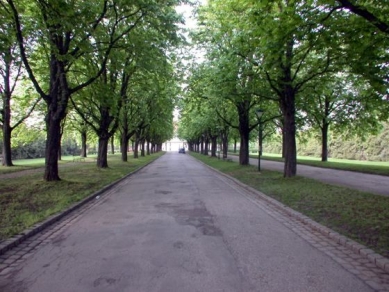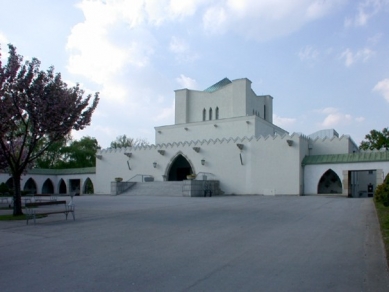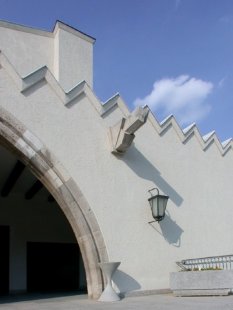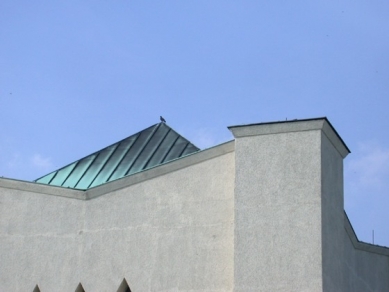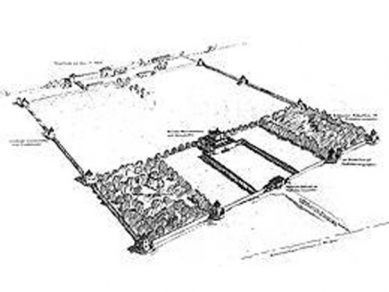
Crematorium, Vienna
Fire Hall Simmering

The crematorium is the most prominent Austrian expressionist building. It laid the foundation for several political systems and initiated a decades-long career for Holzmeister as one of the most influential architects in the country.
The attention-grabbing mystical Gothic forms are the result of the overlapping of several cultural layers. The building, promoting cremation by the Social Democrats, was situated near the central cemetery on the grounds of the decaying imperial palace from the 16th century. Holzmeister was thus able to reinterpret the theme of towers, tinning, and capture a pseudo-religious aura in a fundamentally atheistic ritual.
The mystical tone, expressed in a strongly simplified and orientally Gothic vocabulary, completely suited the general mood of the time after the catastrophe of World War I. Holzmeister only achieved third place in the competition; nevertheless, he was commissioned by the then-conservative chief city architect Fiebiger precisely for his strong symbolism of content and formal regard (according to F. Achleitner ‘semantic coup’), which later led to his employment at the Vienna Academy (1924). Between 1965 and 1969, the crematorium was further expanded by Holzmeister himself: the original main space was enhanced with a large vestibule, and new halls for ceremonies were added (stained glass by Giselbert Hoke). The frescoes in the domed space from 1927 are by Anton Kolig. The gilded walls of the side halls for ceremonies are by Gudrun Baudisch-Wittke.
This funeral hall was built in 1922 according to the plans of Prof. Dr. Techn. Clemens Holzmeister for the city of Vienna under the supervision of Mayor Jakob Reumann. The official in charge was City Councilor Franz Siegel, and the building was managed by Senior Building Councilor Ing. Hans Hafner, Building Councilor Arch. Ing. Friedrich Jäckel, Building Inspector Arch. Ing. Josef Bittner, Building Inspector Ing. Alfred Theiss.
In 1967 and 1969, the building was expanded and adapted to new needs in funerary services. From 1984 to 1986, the technical facilities were reconstructed and the interiors restored. This commemorative plaque was initiated for the centenary of the birth of Prof. Dr. Clemens Holzmeister by the citizens of Vienna, the administration of the city of Vienna under Mayor Dr. Helmut Zilk, and the head of the city council Johann Hatyl.
The attention-grabbing mystical Gothic forms are the result of the overlapping of several cultural layers. The building, promoting cremation by the Social Democrats, was situated near the central cemetery on the grounds of the decaying imperial palace from the 16th century. Holzmeister was thus able to reinterpret the theme of towers, tinning, and capture a pseudo-religious aura in a fundamentally atheistic ritual.
The mystical tone, expressed in a strongly simplified and orientally Gothic vocabulary, completely suited the general mood of the time after the catastrophe of World War I. Holzmeister only achieved third place in the competition; nevertheless, he was commissioned by the then-conservative chief city architect Fiebiger precisely for his strong symbolism of content and formal regard (according to F. Achleitner ‘semantic coup’), which later led to his employment at the Vienna Academy (1924). Between 1965 and 1969, the crematorium was further expanded by Holzmeister himself: the original main space was enhanced with a large vestibule, and new halls for ceremonies were added (stained glass by Giselbert Hoke). The frescoes in the domed space from 1927 are by Anton Kolig. The gilded walls of the side halls for ceremonies are by Gudrun Baudisch-Wittke.
This funeral hall was built in 1922 according to the plans of Prof. Dr. Techn. Clemens Holzmeister for the city of Vienna under the supervision of Mayor Jakob Reumann. The official in charge was City Councilor Franz Siegel, and the building was managed by Senior Building Councilor Ing. Hans Hafner, Building Councilor Arch. Ing. Friedrich Jäckel, Building Inspector Arch. Ing. Josef Bittner, Building Inspector Ing. Alfred Theiss.
In 1967 and 1969, the building was expanded and adapted to new needs in funerary services. From 1984 to 1986, the technical facilities were reconstructed and the interiors restored. This commemorative plaque was initiated for the centenary of the birth of Prof. Dr. Clemens Holzmeister by the citizens of Vienna, the administration of the city of Vienna under Mayor Dr. Helmut Zilk, and the head of the city council Johann Hatyl.
Text on the stone tablets at the entrance
The English translation is powered by AI tool. Switch to Czech to view the original text source.
0 comments
add comment


